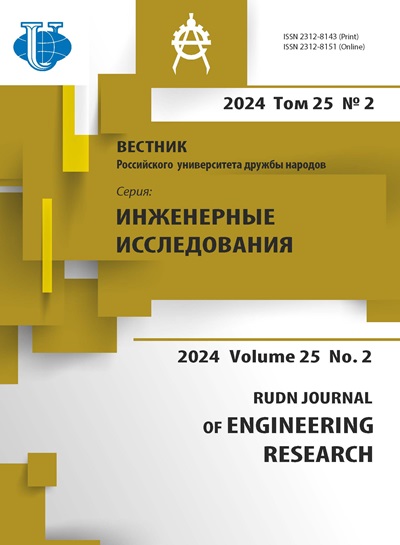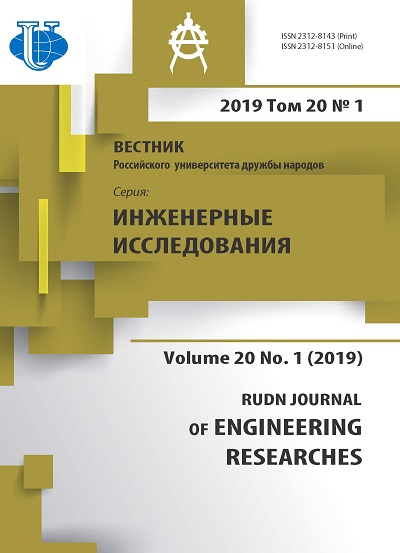Способы оценки сейсмичности территории Сирии
- Авторы: Дубянский А.И.1, Алджабасини Х.2
-
Учреждения:
- Воронежский государственный университет
- Российский университет дружбы народов
- Выпуск: Том 20, № 1 (2019)
- Страницы: 79-84
- Раздел: Науки о земле
- URL: https://journals.rudn.ru/engineering-researches/article/view/21427
- DOI: https://doi.org/10.22363/2312-8143-2019-20-1-79-84
Цитировать
Полный текст
Аннотация
В статье рассмотрены оценки изменения магнитуд сейсмических событий за два года (2005-2006 гг.) по данным сейсмических каталогов. Для этого периода построены и сопоставлены между собой графики закономерности повторяемости землетрясений. Проведен анализ графиков повторяемости ряда зон, построенных при сейсмическом районировании, и определена связь коэффициента А с механизмом очага землетрясения. Выполнено прогнозирование сейсмических событий в регионе на основе сейсмического районирования. Представлено деление территории на районы с разной степенью интенсивности произошедших и ожидаемых землетрясений. Данные сейсмического районирования могут использоваться при проектировании и строительстве сейсмостойких сооружений и для решения других практических задач на сейсмически опасной территории. В этом заключается прикладной аспект сейсмического районирования. Для составления карт сейсмического районирования использованы исторические данные и инструментальные наблюдения за землетрясениями, геолого-тектонические и геофизические карты, а также данные о движении блоков земной коры. Выделены участки возможного возникновения очагов землетрясения (зоны ВОЗ) с различными глубинами. Показано, что наибольшую опасность представляют землетрясения с очагами в пределах земной коры. Приведен статистический анализ по землетрясениям в Сирии с учетом исторических землетрясений на основе летописей. Установлено наличие связей между выявленными землетрясениями и планетарными событиями Земли, в том числе солнечной активностью. Отмечается повышение сейсмической активности в зимнее время.
Ключевые слова
Полный текст
Землетрясение - это одно из самых опасных и практически не предсказуемых природных явлений, изучение которого является важнейшей научной и прикладной задачей современности. Наи- более актуальной эта проблема является в сейсми- чески активных регионах, таких как Аравийская плита и, в частности, ее северо-западная часть, на которой располагается территория Сирии. Необходимость получения здесь максимально полной информации о режиме сейсмичности обусловлена большим объемом гражданских строений и промышленных объектов, возведенных и строящихся без необходимого учета возможной интенсивности сейсмических событий. Данные о сильных исторических землетрясениях относятся еще к VI в., но регулярные инструментальные наблюдения в Сирии начались только в 1995 г., когда была создана Национальная сейсмологическая сеть (SNSN) c центром в г. Дамаске [1- 6]. К настоящему времени SNSN состоит из сорока стационарных телеметрических станций, примерно половина которых оснащена акселерометрами Kinemetrics SSА-I. Этот тип акселерометров ориентирован на регистрацию только сильных природных событий. Остальные оборудованы короткопериодными цифровыми сейсмометрами Kinemetrics SSI и используются для сейсмического мониторинга. Сейсмометры установлены как на скальных и осадочных грунтах, так и на дамбах и в подвалах зданий. Информация о сейсмических событиях, полученная этими станциями, легла в основу детального сейсмического районирования территории Сирии. Результаты сейсмического районирования крайне важны для оценки опасности при строительстве многоэтажных зданий и индустриальных объектов. При этом стоит отметить недостаточность фактических данных о региональной динамике сейсмического режима во временном масштабе. Эта информация необходима для получения сравнительных характеристик современных сейсмотектонических процессов различных регионов. В настоящей работе представлены результаты статистического анализа изменений характера сейсмического режима территории Сирии, которые произошли в течении двух лет. Некоторые результаты нашли свое отражение в следующих публикациях [3-5; 7-9]. Данные о тектонических землетрясениях, которые использованы в данной работе, размещены в Seismological Bulletin from the Syrian National Seismological Network. В Seismological Bulletin from the Syrian National Seismological Netwok за последние десять лет (с января 1995 г.) зарегистрировано около 1200 местных событий с магнитудой 3,5 и более. Анализ этих данных показывает, что сейсмичность Сирии за указанное время может быть охарактеризована от небольшой до умеренной, как это и было в предыдущие века по данным исторических летописей. Большинство инструментально определенных сейсмических событий с магнитудой в интервале 5-6 расположены вдоль Восточно-Анатолийского разлома. В пределах территории выделяется ряд зон слабых событий (М £ 4), таких как южная Пальмира, район Сергая, Южная и Западная части плато Алеппо, регион Басит, а также береговая зона Средиземного моря. В тоже время, по данным Гарвардской сейсмологической обсерватории [4], самые сильные землетрясения на территории Сирии в течение последних двадцати лет произошли на северо-востоке Пальмирид - 20 ноября 1994 г. в 14:31:04 М = 5,3, на юго-востоке Пальмирид - 24 декабря 1996 г. в 22:16:32 М = 5,5 и на юго-западе Латакии - 29 марта 2006 г. в 22:05:18 М = 5,0. Во всех трех случаях тип механизма в очаге определяется как сдвиг. Анализ сейсмических событий, которые произошли в течение двух лет (2006 и 2007 гг.) на территории Сирии, показал, что только за указанный период времени зарегистрировано 532 землетрясения с магнитудой от 0 до 3,7. В среднем магнитуда составляет 2,18. Гипоцентры землетрясений располагаются на глубинах от 1 до 62 км. Средняя глубина очаговых зон составляет примерно 19 км, что согласно скоростной модели земной коры Сирии [4], соответствует глубинам, на которых пластовые скорости продольных и поперечных волн соответственно равны 6,4 и 3,7 км/с. Это соответствует породам диоритового ряда. Для оценки характера изменения сейсмической активности во времени построен график помесячного изменения средней магнитуды сейсмических событий (рис. 1). Отмечается относительная периодичность интенсивности тектонических землетрясений. Она заключается в понижении среднего фона магнитуд в летние месяцы. Период составляет примерно один год. Установлена относительно слабая корреляционная связь магнитуды сейсмических событий с глубиной очаговой зоны (рис. 2). Вполне вероятно, что эта связь при учете более сильных событий будет иметь нелинейный характер [10-15]. В свою очередь глубины гипоцентров определяются тектонической позицией эпицентральных зон. Наиболее сильные землетрясения регистрируются в области разлома Мертвого моря на западе Сирии. Практически все они имеют сдвиговый характер механизма очага. Относительно слабые события, доля которых составляет более 90 %, имеют сбросовый кинематический тип и могут формироваться в широком диапазоне глубин от 12 до 30 км. Рис. 1. График изменения среднемесячного значения магнитуд сейсмических событий в течение двух лет (2005-2006 гг.) [Figure 1. The graph of changes in the average monthly magnitude of seismic events over two years (2005-2006)] Рис. 2. Зависимость магнитуды сейсмических колебаний от глубины очаговой зоны [Figure 2. Dependence of seismic vibration magnitude on the depth of the source zone] По имеющимся данным рассчитаны законы повторяемости землетрясений для 2005 и 2006 гг., графики которых представлены на рис. 3. Графики свидетельствуют о том, что сейсмичность территории Сирии в течение двух лет практически не менялась. По значению коэффициента А отмечается некоторое увеличение сейсмической активности в 2006 г. В работах [16-19] убедительно показана зависимость знака коэффициента А от вероятного механизма очаговой зоны. Отрицательные значения А указывают на сдвиговый характер деформации, который напрямую связан с режимом тектоники плит. В заключение стоит отметить, что территория Сирии и особенно ее периферийная северо-западная часть является сейсмически активной со средней магнитудой около 2. В то же время относительно редко случаются землетрясения с магнитудой более 5 (3 события за 20 лет). В результате анализа каталогов землетрясений за два года получены оценки сейсмичности всей территории Сирии. Установлена относительная периодичность интен- Рис. 3. Законы повторяемости землетрясений на территории Сирии в 2005 и 2006 гг. [Figure 3. The laws of the frequency of earthquakes in Syria in 2005 and 2006] сивности тектонических землетрясений, которая определяется понижением среднего фона магнитуд в летние месяцы. Период спада среднего фона магнитуд составляет примерно один год. Повышение сейсмической активности в зимнее время связано, по-видимому, с активностью солнца и другими процессами планетарного масштаба.
Об авторах
Александр Игоревич Дубянский
Воронежский государственный университет
Автор, ответственный за переписку.
Email: zaina40@hotmail.com
Доцент кафедры геофизических методов поисков и разведки месторождений полезных ископаемых, к.г.-м.н., доцент
Российская Федерация, 394018, Воронеж, Университетская пл., 1Хиба Алджабасини
Российский университет дружбы народов
Email: zaina40@hotmail.com
Аспирант департамента недропользования и нефтегазового дела
Российская Федерация, 117198, Москва, ул. Миклухо-Маклая, 6Список литературы
- Аплонов С.В. Геодинамика: учебник. СПб.: Изд-во С.-Петерб. ун-та, 2001. 360 с.
- Горный В.И., Амар O., Кафри A., Киселев А.В., Крицук С.Г., Латыпов И.Ш., Минини Х. Региональное геологическое строение севера Аравийской плиты и перспективы нефтегазоностности территории Сирии по данным комплексной обработки результатов спутниковых и гравиметрических съемок // Современные проблемы дистанционного зондирования Земли из космоса. 2012. Т. 9. № 1. С. 305-312.
- Девяткин Е.В., Додонов А.Е., Доброва М.Р. и др. Очерки геологии Сирии // Труды ГИН РАН. Вып. 526. М.: Наука, 2000. 204 c.
- Дубянский А.И., Алджабасини Х. Некоторые оценки режима сейсмичности территории Сирии // Вопросы теории и практики геологической интерпретации геофизических полей: материалы 43-й сессии Международного научного семинара им. Д.Г. Успенского. Воронеж: Научная книга, 2016. С. 74-75.
- Оленин В.Б., Зверева О.В., Селицкий А.Г. Нефтегеологическое районирование бассейна Персидского залива // Изв. высш. учеб. завед. Серия: Геология и разведка. 1972. № 2. С. 112-117.
- Seismological Bulletin from the Syrian National Seismological Network. URL: http://www.nec.gov.sy (дата обращения: декабрь, 2018).
- Абрамов В.Ю., Долгинов Е.А. Новые данные о влиянии лунных фаз на землетрясения // Вестник Российского университета дружбы народов. Серия: Инженерные исследования. 2013. № 2. С. 37-44.
- Омар Х.М., Татевосян Р.Э., Ребецкий Ю.Л. Механизмы землетрясений и напряженное состояние земной коры в Сирии // Вестник КРАУНЦ. Серия: Науки о земле. 2012. № 2. Вып. 20. С. 139-147.
- Хаин В.Е., Ломизе М.Г. Геотектоника с основами геодинамики: учебник для студентов геологических специальностей вузов. М.: Изд-во МГУ, 1995. 480 с.
- Абрамов В.Ю., Джамус Али Дауд. Сейсмические данные на шельфе в восточной части Средиземного моря // Инновации и инвестиции. 2017. № 5. С. 150-154.
- Абрамов В.Ю., Макаровский О.В. Геологическая интерпретация сейсмических данных. М.: РУДН, 2019. 116 с.
- Ребецкий Ю.Л., Лукк А.А., Татевосян Р.Э., Быкова В.В. Определение фокальных механизмов слабых землетрясений и современная геодинамика юга Ирана // Геодинамика и тектонофизика. 2017. Т. 8. № 4. С. 971-988.
- Sadovsky M.A., Pisarenko V.F. Сейсмический процесс в блоковой среде. М.: Наука, 1991. 92 с.
- Global CMT catalogue (2012). URL: http://www,globalcmt. org/CMTsearch.html (дата обращения: сентябрь, 2018).
- Hatem M. El Ssayd, Hussam E. Zaineh, Draji Dojcinovski, Vladimir Mihailov. Re-Evaluations of Seismic Hazard of Syria // International Journal of Geoscienes. 2012. No. 3. Pp. 847-855.
- Sadooni F.N., Alsharhan A.S. Stratigraphy, microfacies, and petroleum potential of the Nauddud Formation (AlbianCenomanian) in the Arabian Jult basin // AAPG Bull. 2003. Vol. 87. No. 10. Pp. 1653-1680.
- Mohamad Khir Abdul-Wahed, Ibrahim Al-Tahham. Preliminary outline of the seismologically active zones in Syria // Annals of geophysics. 2010. Vol. 53. No. 4. doi: 10.4401/ag-4683
- Rawaa Dakkak, Maen Mreish, Mohamad Daoud, George Hade. Seismological Research Letters. 2005. Vol. 76. No. 4. Pp. 437-445.
- Sadooni F.N., Alsharhan A.S. Stratigraphy, microfacies, and petroleum potential of the Nauddud Formation (AlbianCenomanian) in the Arabian Jult basin // AAPG Bull. 2003. Vol. 87. No. 10. Pp. 1653-1680.
















